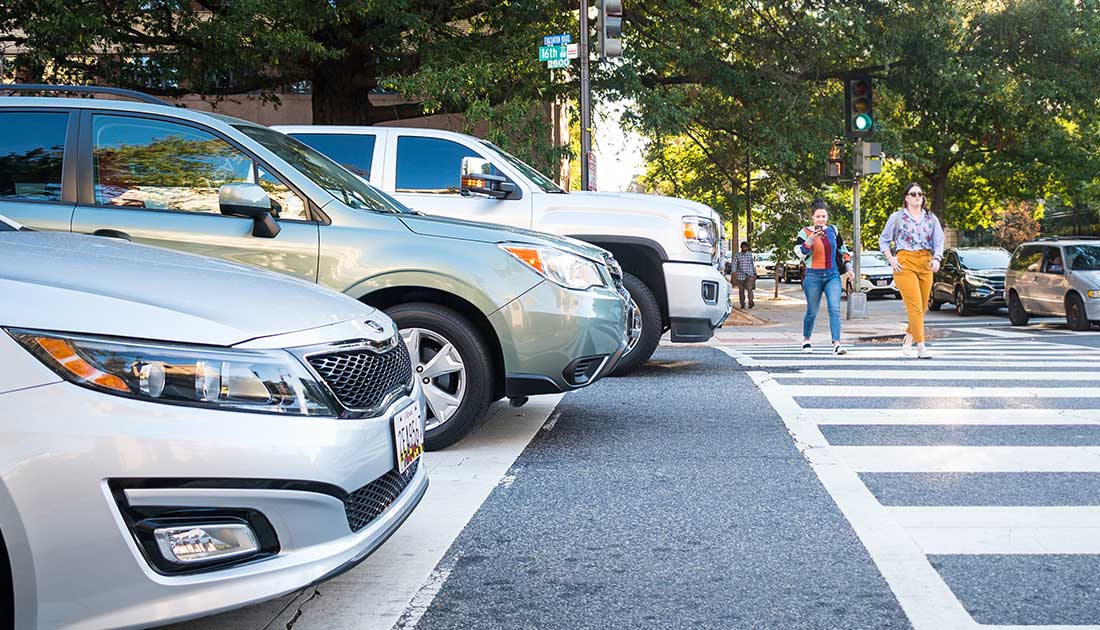SUVs no longer pose outsize risk to car occupants, but pickup compatibility lags
October 10, 2019

It may feel uncomfortable to be a car driver surrounded by taller vehicles, but today’s SUVs aren’t a major threat to occupants of smaller vehicles, new research from the Insurance Institute for Highway Safety shows. Pickups, on the other hand, still represent an outsize danger when they crash with cars, and the weight imbalance is a likely reason.
The improved compatibility of late-model SUVs and cars represents a major shift since the 1990s, when occupants of cars and minivans were far more likely to die in crashes with SUVs than in crashes with other cars and minivans. In contrast, in 2013-16, car occupants were only slightly more likely to die in collisions with 1-4-year-old SUVs than with cars of the same age, relative to the number of each vehicle type on the road.
The trend toward increased compatibility of SUVs with cars and minivans was documented by IIHS researchers in 2011. They attributed the change to stronger structures and side airbags in cars and minivans and to newer SUV designs that lowered the vehicles’ front ends to better align with cars’ energy-absorbing structures. These more compatible designs were the result of a 2003 voluntary commitment by automakers that the Institute helped broker.
“For a long time, the front ends of SUVs were so high that they bypassed the energy-absorbing structures of the fronts of cars,” says Joe Nolan, IIHS senior vice president for vehicle research and a co-author of both the earlier study and the new one. “The changes prompted by the voluntary commitment largely resolved that issue.”
The trend toward better crash compatibility between cars and SUVs has continued, the new study shows. In 2013-16, the rate at which car drivers were killed in crashes with 1-4-year-old SUVs was just 28 percent higher than the rate that car drivers were killed in crashes with other cars, also between 1 and 4 years old. That compares with 132 percent in 1989-92 and 59 percent in 2009-12.
Rate of car driver deaths in crashes with SUVs and pickups, relative to death rate in crashes with other cars
“The fact that car-SUV compatibility has continued to improve long after the voluntary commitment is probably a result of improved crashworthiness in the smallest vehicles,” Nolan says. “Small cars and minicars used to have the worst ratings in our crash tests but have made big strides in recent years.”
Although the voluntary commitment resulted in more compatible pickup designs too, pickup-car compatibility is still lacking. The car driver death rate in crashes with pickups increased steadily between 1989 and 2008, relative to the car driver death rate in crashes with other cars. This gap began to close over the last decade but remains large. In 2013-16, pickups were 2½ times as likely to be involved in a crash that was fatal for a car or minivan driver than other cars and minivans were.
To see how much of the remaining problem is due to weight differences versus design issues, the researchers repeated their analysis with only vehicles weighing between 3,500 and 4,000 pounds. The car driver death rate in crashes with light pickups in this weight range was just 23 percent higher than it was in crashes with cars of similar weight. The car driver death rate in crashes with light SUVs of this weight was slightly lower than in crashes with cars. These results point to weight differences as a likely source of continued incompatibility.
But would shedding weight make pickups and SUVs less protective of their own occupants? To find out, researchers also looked at death rates among the pickup and SUV drivers themselves. For the earlier years, the death rates among light pickup and light SUV drivers were much higher compared with their full-sized counterparts. In 2013-16, however, lighter vehicles were not associated with as much of an increase in driver death rates. In other words, higher curb weight doesn’t seem to play as big a role in protecting SUV and pickup occupants as it once did.
“More sophisticated designs that do a better job of managing forces in a crash, along with electronic stability control and other crash avoidance features, have made the sheer weight of a vehicle less important,” Nolan says. “This suggests that reducing the weight of the heaviest vehicles for better fuel economy — for example, by switching from steel to aluminum — can improve safety for other road users without sacrificing occupant protection.”